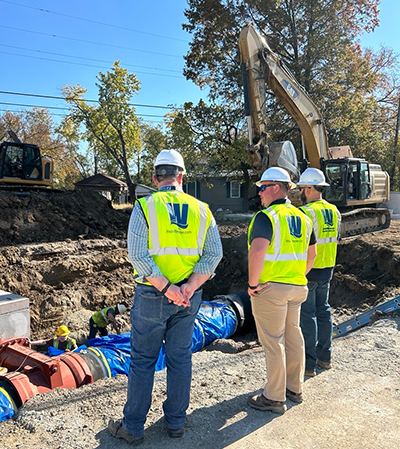Over the next five years, Louisville Water projects to spend $730 million on capital projects, with $200 million allotted in 2025 alone.
Infrastructure improvements, redundancy, and regional growth are the focus areas behind those big investments.
Louisville Water Chief Engineer Larry Bryant presented these plans at Louisville MSD’s 10th annual Can You Dig It? event on January 16, which educated potential contractors, engineers, and diverse suppliers of the utility projects planned for 2025 and beyond.

“The biggest chunk of (our budget) is maintaining our infrastructure,” said Bryant. “We reinvest a lot in our infrastructure, which allows us to maintain our reliable, high-quality service.”
Louisville Water’s service extends south along the I-65 corridor and the growth in this also drives much of the work through 2030.
 Developments like BlueOval SK use a lot of water, requiring additional pipelines, pump stations, and water tanks. Collaboration with regional partners like Hardin County Water District No. 2 are essential in supplying water to more residents and businesses.
Developments like BlueOval SK use a lot of water, requiring additional pipelines, pump stations, and water tanks. Collaboration with regional partners like Hardin County Water District No. 2 are essential in supplying water to more residents and businesses.
Currently, one in five Kentuckians and over 24,000 businesses rely on Louisville Water daily. This includes a mix of small businesses, schools, hospitals, restaurants, large manufacturing facilities, and soon – a data center campus.
On the same day as Can You Dig It?, Powerhouse Data Center and Poe Companies announced it’s bringing Kentucky’s first-ever data center campus to Louisville, creating hundreds of full-time jobs and construction projects.
Louisville Water’s expertise in water treatment and delivery and access to the Ohio River played a key role in securing the new development.
So, where does water come into the equation?
For a data center, water is typically part of the cooling operations along with the fire protection needed on-site. On the power side, it takes enormous energy to handle the data that comes from phones, streaming services, and the digital functions of our society.
“This mega investment proves that water and power do, in fact, mix to create economic opportunities for our city and state,” said Kelley Dearing Smith, Vice President of Strategic Communications and Marketing.
 Attracting new business and executing capital projects, like the ones outlined at Can You Dig It?, requires a coordinated effort between elected officials, utilities, planning and design, and so many more.
Attracting new business and executing capital projects, like the ones outlined at Can You Dig It?, requires a coordinated effort between elected officials, utilities, planning and design, and so many more.
But a hyperscale operator demands even more resources and proactive planning, marking a critical milestone for the Commonwealth.
“This announcement is a perfect example of what can happen when everyone gets a seat at the table from the very beginning,” said Dearing Smith.

